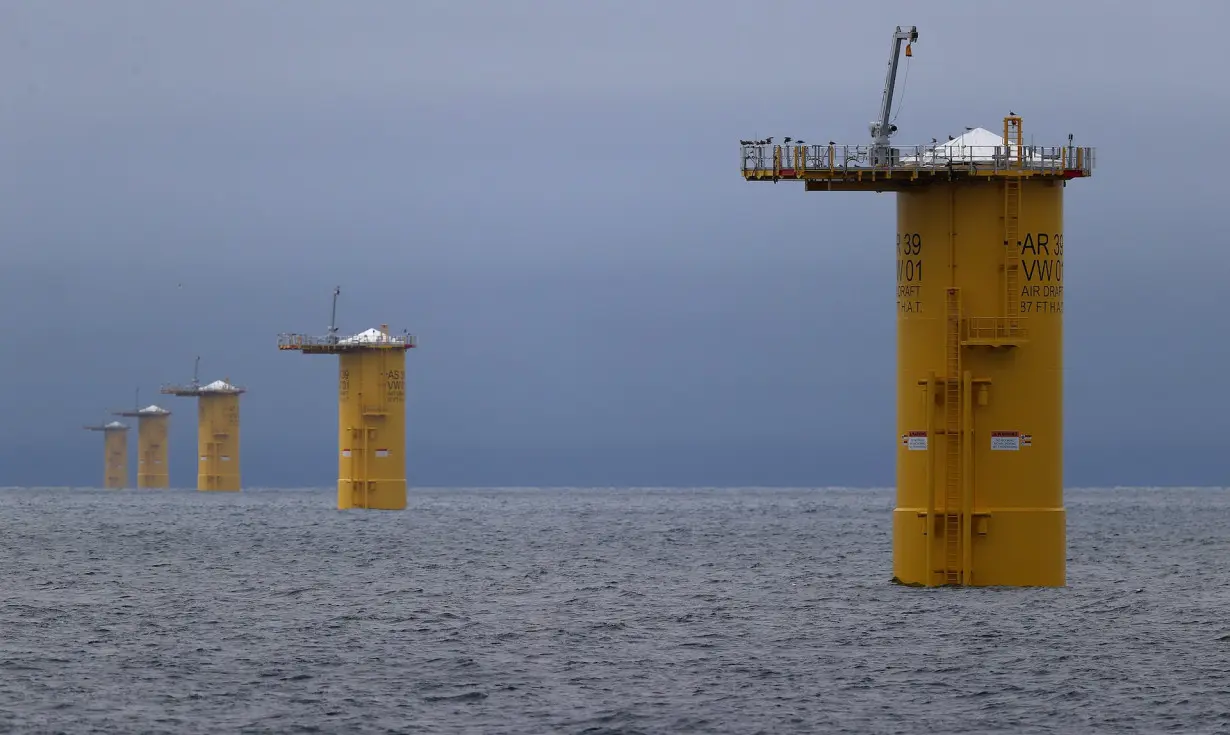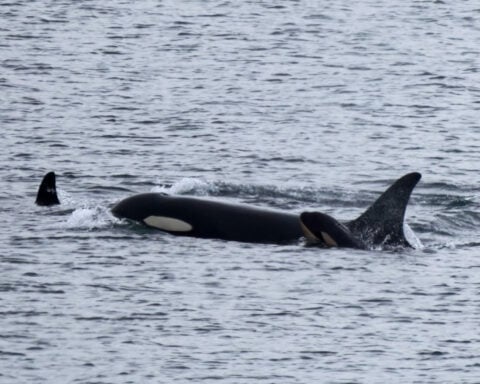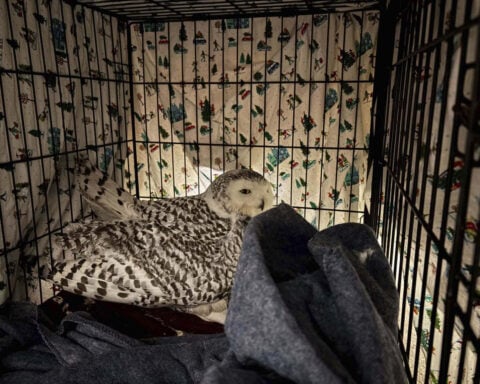As renewable energy production expands across the U.S., the environmental impacts of these new sources are receiving increased attention. In a recent report, the National Academies of Sciences, Engineering, and Medicine examined whether and how constructing offshore wind farms in the Nantucket Shoals region, southeast of Massachusetts, could affect critically endangered North Atlantic right whales. The Conversation asked marine scientists Erin L. Meyer-Gutbrod, Douglas Nowacek, Eileen E. Hofmann and Josh Kohut, all of whom served on the study committee, to explain the report’s key findings.
Why did this study focus on such a specific site?
The Bureau of Ocean Energy Management, which is part of the U.S. Department of the Interior and regulates offshore energy production, asked the National Academies to conduct this study. Regulators wanted to better understand how installing and operating offshore, fixed-bottom wind turbine generators would affect physical oceanographic processes, such as tides, waves and currents, and in turn how those changes could affect the ecosystem.
For example, offshore wind turbines decrease wind speeds behind them, and the presence of their structures makes the water more turbulent. These changes could affect ocean currents, surface wind speeds and other factors that influence hydrodynamics – the structure and movement of the water around the turbines.
The Nantucket Shoals region is a large, shallow area in the Atlantic that extends south of Cape Cod. Our report focused on it because this is the first large-scale offshore wind farm area in the U.S., and the region has been included in several recent hydrodynamic modeling studies.

Why are North Atlantic right whales of special concern?
North Atlantic right whales are critically endangered. Scientists estimate that the population is down to just 356 animals.
This species was almost driven to extinction after centuries of commercial whaling. Even though the whales have been protected from whaling for almost 100 years, they are still accidentally killed when they are hit by vessels or become entangled in fishing gear. These two sources of mortality are responsible for most documented juvenile and adult right whale deaths over the past 25 years.
There are options for protecting them, such as slowing or rerouting boats, shortening the fishing season or even modifying fishing gear to make it more whale-safe. However, regulators need to know where the whales are going to be and when they’ll be there, so they can put those protections in place.
It’s usually hard to figure out where whales are – they have a large habitat and spend most of their time below the surface of the water, where observers can’t see them. Recently it’s gotten even harder, because climate change is causing whales to shift where and when they feed.
Currently, right whales are spending more time around the Nantucket Shoals region. This means scientists and managers need to make sure that wind energy development in the area is happening safely and that threats to whales in the area are reduced.
How might offshore wind farms affect right whales in the study area?
Right whales are filter feeders that consume huge quantities of tiny zooplankton. The whales need to find large, dense patches of zooplankton at appropriate water depths in order to feed. Altering waves, tides and currents in ways that affect where their prey are located could affect whale feeding or cause the whales to change foraging habitats.
We concluded that it is critical to consistently monitor right whales and their prey within and outside the region, because we don’t know whether wind development will cause an increase, a decrease or no change to their zooplankton prey. Consistent monitoring will allow managers to mitigate potential negative impacts on the whales.
Researchers will need to collect data during all phases of wind farm construction and operation and develop robust models to determine whether wind farms will affect prey availability for right whales in the study area. Even once they do this research, it will still be difficult to isolate potential impacts from wind farms.
There is a tremendous amount of both natural and human-driven variability and change in this region, including tides, seasonal changes in water temperature and long-term ocean warming driven by climate change. Climate-driven shifts in prey in distant regions, such as the Bay of Fundy or the Gulf of St. Lawrence, may also change how right whales use the Nantucket Shoals region.
Development of the first wind energy farms in the Nantucket Shoals region is a valuable opportunity to better understand hydrodynamic impacts of turbines on marine ecosystems. We expect that it will help guide future development of wind farms along the U.S. East Coast.

What are the most important knowledge gaps?
Few studies have been done to understand hydrodynamics around wind energy turbines, and those that exist focus on European offshore wind farms in the North Sea, where conditions are different from Nantucket Shoals. Large turbines of the size planned for the Nantucket Shoals region have not been built yet in U.S. waters.
Researchers have tried to model the hydrodynamic impacts of turbines, but their results don’t always agree with each other. There’s a need for more work to compare different types of models with each other, and with actual observations in the ocean, to make sure that they represent key processes like tides, stratification, turbulence and drag correctly.
The most accurate outputs will likely come from using a range of models. Oceanographers might start with models that predict what happens as water moves past a single turbine. These results then would inform models that predict the effects of an entire wind farm. Then results from wind farm-scale models would be incorporated into models that predict regional ocean circulation.
There are also a lot of knowledge gaps on the biology side, including questions about what species of zooplankton are in the Nantucket Shoals region, where they come from and what makes them aggregate into patches that are dense enough for right whales to eat. Right whale feeding in the Nantucket Shoals region isn’t well understood, so scientists need more observations to determine which zooplankton types are targeted by right whales and where and when the whales feed.
Does the report call for slowing offshore wind development until these questions are answered?
No, and we were not asked to provide recommendations for how the wind industry should proceed with construction.
Nantucket Shoals is one of many regions where large-scale wind farms will be built in U.S. waters over the coming decades. Our committee advised federal regulators and other relevant organizations to conduct observational and modeling research to better understand hydrodynamic and ecological processes before, during and after wind farm construction. These studies will be critical for understanding and addressing environmental impacts from offshore wind farm development.
Richard Merrick, former chief science adviser and director of scientific programs at National Oceanic and Atmospheric Administration Fisheries, and Kelly Oskvig, National Academies of Sciences, Engineering, and Medicine director of the study described here, contributed to this article.

Erin L. Meyer-Gutbrod receives funding from the Bureau of Ocean Energy Management. She serves as a volunteer on the Marine Mammal Subcommittee of the Regional Wildlife Science Collaborative for Offshore Wind.
Douglas Nowacek receives funding from the U.S. Department of Energy and the Bureau of Ocean Energy Management.
Eileen E. Hofmann receives funding from the Bureau of Ocean Energy Management.
Josh Kohut receives funding from the U.S. Department of Energy. He serves as a volunteer member of the board of directors for the Marine Technology Society.
Source: The Conversation

 US weekly jobless claims fall slightly
US weekly jobless claims fall slightly
 FTX executives shave serious time off their sentences
FTX executives shave serious time off their sentences
 US applications for unemployment benefits hold steady, but continuing claims rise to 3-year high
US applications for unemployment benefits hold steady, but continuing claims rise to 3-year high
 Guatemala open to accepting Trump's Central American deportees, sources say
Guatemala open to accepting Trump's Central American deportees, sources say
 Azerbaijan Airlines flight was downed by Russian air defence system, four sources in Azerbaijan say
Azerbaijan Airlines flight was downed by Russian air defence system, four sources in Azerbaijan say
 NATO calls for full investigation of Azerbaijan Airlines crash
NATO calls for full investigation of Azerbaijan Airlines crash
 Simona Halep withdraws from Australian Open qualifying because of knee and shoulder pain
Simona Halep withdraws from Australian Open qualifying because of knee and shoulder pain
 Why this Mexican American woman played a vital role in the US sacramental peyote trade
Why this Mexican American woman played a vital role in the US sacramental peyote trade
 What is the Native American Church and why is peyote sacred to members?
What is the Native American Church and why is peyote sacred to members?
 A row of monopiles that will be the base for offshore wind turbines, in the Atlantic Ocean off the coast of Martha
A row of monopiles that will be the base for offshore wind turbines, in the Atlantic Ocean off the coast of Martha







